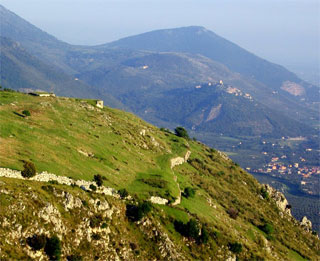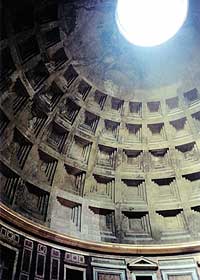itineraries
ghosts of the via appia 5-13 May 2007
8 days/7 nights US$1975 per person*
Price: US$1975 per person (double occupancy) includes all meals, lodging, transportation and baggage shuttle (on public transport we will carry our own luggage). 20% supplement for single room occupancy. Air fare to Rome not included.
>Extra days in Rome can be booked on request.
Signing up: a $300 deposit will hold your dates (refundable until a month before the trip). Booking closes 28 February 2007. Limited to 6 persons.
Please write to me with questions or to sign up.
Please note: this is an open group excursion with fixed itinerary and dates (5-13 May 2007). If you prefer to choose your own itinerary and dates, see paths into history
> an 8-day pre-planned excursion combining two days in Rome with highlights of the Alban Hills and Lepini Mountains.
Circus of Maxentius - Rome
Signing up: a $300 deposit will hold your dates
(refundable until a month before the trip).
Booking closes 28 February 2007. Limited to 6 persons.
Please write to me with questions or to sign up.
Day 1 (Saturday 5 May): Rome
(1-4 easy miles)
Your part is getting to Rome. If you like, I’ll meet you at the airport or train and accompany you to your hotel. Depending on your energy level, we’ll stroll the historic city center and breathe in some of its fascination. After a tasty dinner in one of my favorite hangouts I’ll leave you to retire early.
Day 4: Nemi’s holy precincts
(about 5-6 miles, moderately hilly)
This region of volcanic lakes and mountains has been considered mysterious and sacred since the dawn of history. We’ll climb out of the Albano crater; deep in the forest we’ll discover a hidden Roman road, the Via Sacra (Sacred Way), which once led from the Via Appia to a Temple of Jupiter on the summit of Monte Cavo. A curious good-luck charm protrudes from a paving stone where the road becomes steep. We’ll hike past the spring of the water-nymph Egeria and down the slope of another crater to Nemi town, terraced up a rock overlooking exquisite Lake Nemi: “Diana’s mirror,” once home to the Sanctuary of Diana. We’ll lodge here in a friendly inn, and dine in one of Nemi’s excellent restaurants.
Day 3: Albano and its lake
(about 4-5 miles, moderately hilly)
Morning train to Albano, a lively town built atop ruins of a Roman army camp and chock-full of fascinating stuff. Houses cluster against the camp’s stone walls and into chunks of an ancient bath complex. We’ll visit remnants of a Roman villa, a great amphitheatre, and the last still-functioning Roman cistern in Europe - an astonishing barrel-vaulted structure half buried in the earth. After lunch overlooking Lake Albano’s crater we’ll follow a scenic trail to a former monastery stunningly situated on a rocky slope above the lake, where we’ll be fed and lodged for the night. For those still with energy, a brief scramble through the woods leads to the eerie remains of an eleventh-century hermitage.
Day 2: the Via Appia near Rome
(about 4 easy miles)
After breakfast we’ll ride the bus past the old city gates to the best-known, classic stretch of the Via Appia, immortalized by the paintings and engravings of countless artists who set out on the “Grand Tour” and were captivated by this nostalgic scene reminiscent of Rome’s great past. A decades-long struggle led to the establishment of the Via Appia Regional Park, a wide swath of greenbelt protected from the surrounding urban sprawl. The road is lined with evocative tombs and sculptural portrayals of ancient Romans. We’ll ramble for a few miles, enjoying lunch along the way. In the evening we’ll sample another of the wonderful eating establishments in the city center.
Day 6: Norba and Sermoneta
(about 6-7 miles with a few steep parts)
Norba was flourishing Roman settlement with homes, temples, paved streets, cisterns and baths, perched on the edge of a steep slope high over the coastal plain and enclosed by a long defensive wall of massive white blocks. But in the civil war between Marius and Sulla, Norba chose the wrong side. The historian Appian tells us that in 81 BC, as the forces of Sulla were closing in and no hope remained, the inhabitants destroyed the city and committed suicide. The ruins are fascinating and the views stunning: snow-capped peaks above, the idyllic Gardens of Ninfa and the coastal plain below. After lunch in the adjacent cliffside village of Norma, we’ll descend a mountain trail to the graceful 13th-century Abbey of Valvisciolo on our way to the medieval hill town of Sermoneta, where we’ll wander through the labyrinth of gleaming limestone-paved streets. After dinner we’ll lodge in a delightfully restored stone villa.

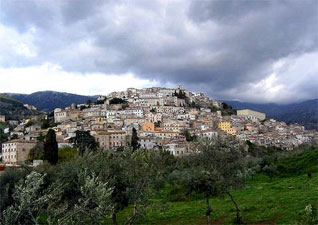
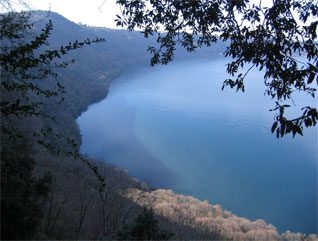

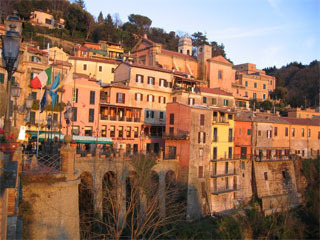
Day 5: Cori – gateway to the Lepini Mountains
(about 5-6 miles, moderately hilly)
In the morning we’ll follow a panoramic trail around Lake Nemi to Genzano, famous for its crusty bread, and travel by auto to Cori, a bustling town with pre-Roman roots at the edge of the Lepini Mountains. Built on ancient limestone terraces that run from top to bottom of a steep hill, Cori is walled with imposing polygonal blocks. Here an ancient road ran south before the Via Appia: a Roman bridge still straddles the steep canyon flanking the town. Many other Roman and medieval structures make Cori a delight to explore – and tourists are nowhere to be seen. We’ll dine at an exceptional restaurant and sleep in a recently refurbished 16th-century monastery.

Day 7: Sermoneta
(about 5-6 miles, moderately hilly)
In the morning we’ll relax in Sermoneta’s beautiful piazza before heading out on a morning walk to the charming nearby village of Bassiano, known for its delicious locally-produced prosciutto. On the way we’ll see some of the characteristic limestone formations and shady forests of the Lepini Mountains. After lunch in Bassiano’s recently restored piazza we’ll catch a bus back to Sermoneta. We’ll dine in an atmospheric spot next to the castle and enjoy another night in the old villa.
Day 8: Caetani Castle tour; return to Rome (Saturday, 13 May)
(about 2-3 easy miles)
Built in the 12th century and expanded several times until the 15th century, the Caetani Castle is considered one of the most important examples of defensive architecture in central Italy, with renovations by the famous Renaissance architect, Antonio da Sangallo the Elder. We’ll enjoy a final lunch in Sermoneta’s piazza and catch an afternoon train back to Rome.
>Extra days in Rome can be booked on request.
“…fabulous, relaxing, inspiring… I’ll definitely return.”
Alice M.
Watsonville, California
|






